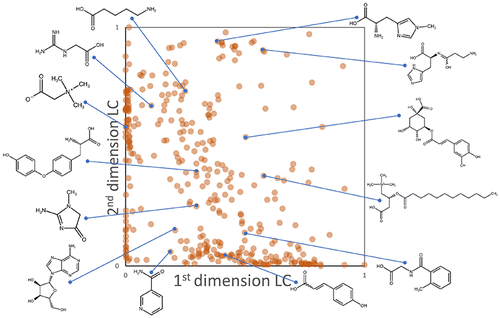当前位置:
X-MOL 学术
›
Anal. Chem.
›
论文详情
Our official English website, www.x-mol.net, welcomes your feedback! (Note: you will need to create a separate account there.)
Systematic Evaluation of Liquid Chromatography (LC) Column Combinations for Application in Two-Dimensional LC Metabolomic Studies
Analytical Chemistry ( IF 7.4 ) Pub Date : 2021-09-07 , DOI: 10.1021/acs.analchem.1c01857 Maria Grübner 1, 2 , Andreas Dunkel 1, 3 , Frank Steiner 2 , Thomas Hofmann 1
Analytical Chemistry ( IF 7.4 ) Pub Date : 2021-09-07 , DOI: 10.1021/acs.analchem.1c01857 Maria Grübner 1, 2 , Andreas Dunkel 1, 3 , Frank Steiner 2 , Thomas Hofmann 1
Affiliation

|
In comparison to proteomics, the application of two-dimensional liquid chromatography (2D LC) in the field of metabolomics is still premature. One reason might be the elevated chemical complexity and the associated challenge of selecting proper separation conditions in each dimension. As orthogonality of dimensions is a major issue, the present study aimed for the identification of successful stationary phase combinations. To determine the degree of orthogonality, first, six different metrics, namely, Pearson’s correlation coefficient (1 – |R|), the nearest-neighbor distances (H̅NND), the “asterisk equations” (AO), and surface coverage by bins (SCG), convex hulls (SCCH), and α-convex hulls (SCαH), were critically assessed by 15 artificial 2D data sets, and a systematic parameter optimization of α-convex hulls was conducted. SGG, SCαH with α = 0.1, and H̅NND generated valid results with sensitivity toward space utilization and data distribution and, therefore, were applied to pairs of experimental retention time sets obtained for >350 metabolites, selected to represent the chemical space of human urine. Normalized retention data were obtained for 23 chromatographic setups, comprising reversed-phase (RP), hydrophilic interaction liquid chromatography (HILIC), and mixed-mode separation systems with an ion exchange (IEX) contribution. As expected, no single LC setting provided separation of all considered analytes, but while conventional RP×HILIC combinations appeared rather complementary than orthogonal, the incorporation of IEX properties into the RP dimension substantially increased the 2D potential. Eventually, one of the most promising column combinations was implemented for an offline 2D LC time-of-flight mass spectrometry analysis of a lyophilized urine sample. Targeted screening resulted in a total of 164 detected metabolites and confirmed the outstanding coverage of the 2D retention space.
中文翻译:

液相色谱 (LC) 色谱柱组合在二维 LC 代谢组学研究中的系统评价
与蛋白质组学相比,二维液相色谱(2D LC)在代谢组学领域的应用还为时过早。一个原因可能是化学复杂性的提高以及在每个维度中选择合适的分离条件的相关挑战。由于维度的正交性是一个主要问题,本研究旨在鉴定成功的固定相组合。为了确定正交度,首先,六个不同的度量,即皮尔逊相关系数(1 – | R |)、最近邻距离(H̅ NND)、“星号方程”(A O)和表面覆盖率bins (SC G ),凸包 (SC CH)) 和 α-凸包 (SC αH ),通过 15 个人工二维数据集进行严格评估,并进行了 α-凸包的系统参数优化。SG ģ,SC αH与α= 0.1,ħ NND产生了对空间利用和数据分布敏感的有效结果,因此,应用于为 >350 代谢物获得的成对实验保留时间集,选择代表人类尿液的化学空间。获得了 23 种色谱设置的归一化保留数据,包括反相 (RP)、亲水相互作用液相色谱 (HILIC) 和具有离子交换 (IEX) 贡献的混合模式分离系统。正如预期的那样,没有单一的 LC 设置提供所有考虑分析物的分离,但是虽然传统的 RP×HILIC 组合看起来更像是互补而不是正交,但将 IEX 特性纳入 RP 维度显着增加了 2D 潜力。最终,最有前途的色谱柱组合之一用于对冻干尿样进行离线 2D LC 飞行时间质谱分析。有针对性的筛选共检测到 164 种代谢物,并证实了 2D 保留空间的出色覆盖。
更新日期:2021-09-21
中文翻译:

液相色谱 (LC) 色谱柱组合在二维 LC 代谢组学研究中的系统评价
与蛋白质组学相比,二维液相色谱(2D LC)在代谢组学领域的应用还为时过早。一个原因可能是化学复杂性的提高以及在每个维度中选择合适的分离条件的相关挑战。由于维度的正交性是一个主要问题,本研究旨在鉴定成功的固定相组合。为了确定正交度,首先,六个不同的度量,即皮尔逊相关系数(1 – | R |)、最近邻距离(H̅ NND)、“星号方程”(A O)和表面覆盖率bins (SC G ),凸包 (SC CH)) 和 α-凸包 (SC αH ),通过 15 个人工二维数据集进行严格评估,并进行了 α-凸包的系统参数优化。SG ģ,SC αH与α= 0.1,ħ NND产生了对空间利用和数据分布敏感的有效结果,因此,应用于为 >350 代谢物获得的成对实验保留时间集,选择代表人类尿液的化学空间。获得了 23 种色谱设置的归一化保留数据,包括反相 (RP)、亲水相互作用液相色谱 (HILIC) 和具有离子交换 (IEX) 贡献的混合模式分离系统。正如预期的那样,没有单一的 LC 设置提供所有考虑分析物的分离,但是虽然传统的 RP×HILIC 组合看起来更像是互补而不是正交,但将 IEX 特性纳入 RP 维度显着增加了 2D 潜力。最终,最有前途的色谱柱组合之一用于对冻干尿样进行离线 2D LC 飞行时间质谱分析。有针对性的筛选共检测到 164 种代谢物,并证实了 2D 保留空间的出色覆盖。



























 京公网安备 11010802027423号
京公网安备 11010802027423号